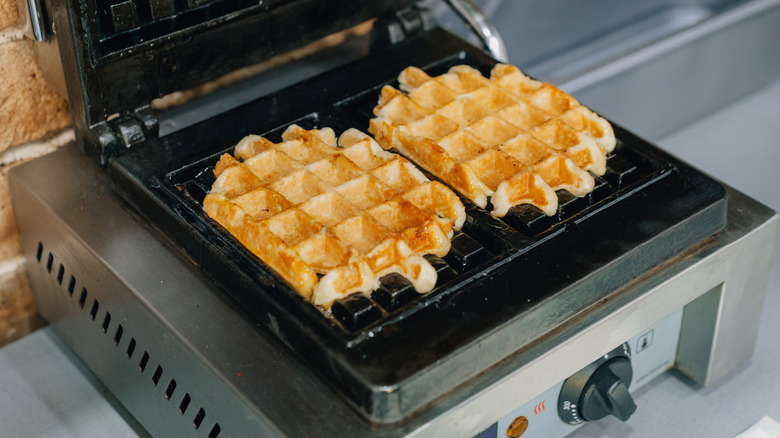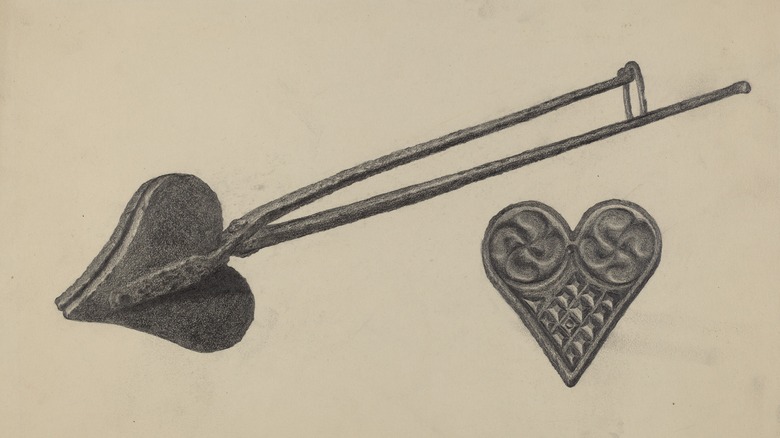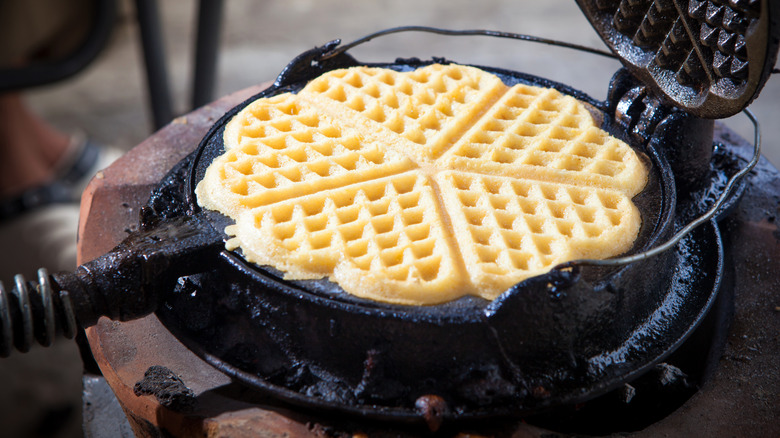The Waffle Iron's Ancient Greek Origins
If you think of waffles, what country comes to mind? It's Belgium, isn't it? The small European nation made its name synonymous with the beloved checkerboard snack at the 1964 World's Fair in New York City when Belgian chef Maurice Vermeersch set up a vending booth called "Bel-gem," serving the type of fluffy, deeply-dimpled waffles that were popular in his homeland (via Culture Trip). The booth's popularity (Vermeersch reportedly sold up to 2,500 waffles per day) has led us to associate waffles with Belgium ever since.
However, while Belgium can be regarded as the modern waffle capital, it cannot claim to have invented the food as you might expect it to. In actuality, waffles evolved over centuries, and the development of each type of waffle often happened due to changes in the tool used to make them: The waffle iron. Over the years, waffle irons went from unreliable and even dangerous devices to the convenient electric ones we know today. This delectable journey began, as so many Western technologies did, in Ancient Greece.
Early waffle irons
Ancient Greek innovations mark the origins of many modern technologies. World Atlas credits Greece with inventing the first alarm clocks, odometers, vending machines (which were coin-operated water fountains), and more. However, the ancient culture rarely receives credit for the waffle iron, which we will aim to correct right now. According to Mental Floss, food historians have traced the origin of waffles to Greek 'obelios,' which were flat cakes roasted between a pair of metal plates attached to long wooden handles. Made from just flour and water, they surely lacked the sweet appeal of modern waffles.
Over time, obelios spread throughout Europe. By the 13th century, they were a common foodstuff throughout the continent, enjoyed by nobles and peasants. Smithsonian Magazine notes that the name was adapted to the French 'oublies,' and people began customizing the metal plates used for cooking with unique designs. Early iterations featured religious iconography, family crests, and animal depictions. Per Mental Floss, the grid-patterned waffles we know today came about in the 15th century when Dutch waffle makers switched from round to rectangular metal plates for cooking. The Online Etymology Dictionary notes that this grid pattern likely led to the name 'waffle,' which descends from the Proto-Germanic 'wabila,' meaning 'web' or 'honeycomb.'
How the waffle iron evolved
The Crusades triggered one of the most important developments in waffle history. Per Mental Floss, when Crusaders returned to Europe, they brought spices such as cinnamon and ginger. Cooks began spicing up their oublie batter, and it should come as no surprise that these overtook the traditional, bland wafer. Eventually, people started adding leavening agents to the batter, which required them to make the cooking irons deeper. With this development, waffles went from a thin cracker-like food to the fluffy delights we now enjoy. However, there were some serious issues with the original handheld waffle irons. Smithsonian Magazine notes that they were extremely heavy and awkward to handle. They made it hard to check on the waffle as it cooked, and people often burnt theirs. More importantly, the cook had to hold the iron over an open fire, and many people scorched their hands.
Our fingers were saved from the flames when Cornelius Swartwout of Troy, New York, invented a stovetop version of the waffle iron. According to Mental Floss, it was made of cast iron and looked very similar to modern waffle irons, having a hinged top and a protective handle with which to open and flip the iron. Smithsonian reports that Swartwout secured a patent for his waffle iron in 1869. August 24th, the day his patent was issued, is now celebrated as National Waffle Day, one of many seemingly random food holidays that dot our yearly calendars.


